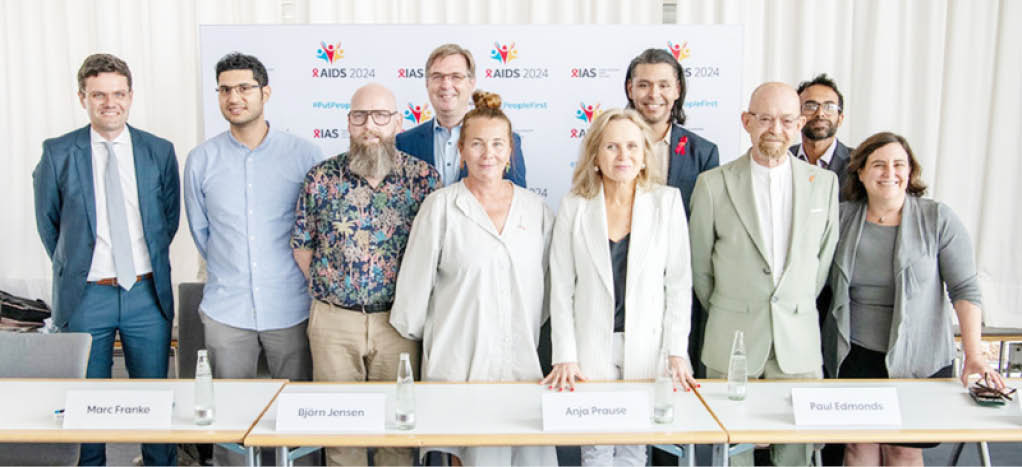The cure for the Human Immunodeficiency Virus (HIV) has been sought since the discovery of the disease about four decades ago.
HIV is a virus that attacks the body’s immune system. Acquired Immunodeficiency Syndrome (AIDS) occurs at the most advanced stage of infection.
There were an estimated 39.9 million people living with HIV worldwide at the end of 2023 with 65% of them in the WHO African Region.
Also in 2023, an estimated 630,000 people died from HIV-related causes and an estimated 1.3 million acquired HIV.
- Tinubu Commissions CNG Buses At Presidential Villa
- OPEC says Chinese economy pulling down oil demand
In Nigeria, 1.9 million people are living with HIV, comprising 1.8 million adults (92%) and 160,000 (8%) children.
So far, only seven people are known to have been cured of the HIV worldwide. Albeit, over the years, scientists have been recording advances and progress towards prevention and achieving a functional cure for the disease.
Aside the seven persons, till date according to the World Health Organisation (WHO), there is no cure for HIV infection. Although it said with access to effective HIV prevention, diagnosis, treatment and care, including for opportunistic infections, HIV infection has become a manageable chronic health condition, enabling people living with HIV to lead long and healthy lives.
Most of the HIV cured cases were achieved after stem cell transplant. That is people who have HIV received stem cells from people who had natural resistance to HIV infection as a result of the presence of the double CCR5-delta-32 mutation.
Medical experts say people with this rare genetic mutation do not have CCR5 receptors on their immune system cells. The mutation has been found to stop HIV from entering cells.
Stem cells are cells produced by bone marrow (a spongy tissue found in the centre of some bones) that can turn into new blood cells.
According to experts, the latest case and world’s seventh person cured of HIV called “Next Berlin Patient”, following a stem cell transplant that shows progress towards a cure for the disease.
They made their findings about the “Next Berlin Patient” known for the first time during the 25th International AIDS Conference (AIDS 2024) which took place in Munich, Germany and virtually on July 22 to 26.
The scientists say this is the first HIV cure case in which the donor had a single, rather than double CCR5-delta32 mutation, which could have promising implications for future research.
Speaking during a media roundtable at the conference, the experts explained that the fact that this appears to be the first HIV cure case in which the stem cell donor had a single, rather than double, CCR5-delta32 mutation could have promising implications for future, more scalable HIV cure strategies.
In most HIV cure cases following stem cell transplants, the donors had naturally inherited two copies of the CCR5-delta32 mutation – one from each parent. Also known as homozygous, these individuals are essentially immune to HIV.
This is the first HIV cure case in which the donor had inherited just one copy of the CCR5-delta32 mutation – known as heterozygous.
These individuals can acquire HIV, but the virus generally progresses slowly if they do not receive antiretroviral treatment. More people have the heterozygous mutation than the homozygous mutation.
Christian Gaebler, Group Leader, Translational Immunology of Viral Infections, Charité-Universitäts medizin Berlin, said the “next Berlin Patient” had both leukaemia and HIV. He received a stem cell transplant for leukaemia in late 2015; then, in late 2018, he stopped taking antiretroviral treatment for HIV. About five-and-a-half years later, he remains in HIV remission.
Gaebler who presented the study said it concludes that “effective reservoir reductions, durable HIV remission and potential cure can be achieved with functional viral co-receptors, suggesting that allogeneic immunity fundamentally contributes to HIV eradication”.
“A healthy person has many wishes, a sick person only one,” said the ‘next Berlin Patient’, who has chosen to remain anonymous.
President of the International AIDS Society and AIDS 2024 International Co-Chair, Sharon Lewin said, “The next Berlin Patient’s experience suggests that we can broaden the donor pool for these kinds of cases, although stem cell transplantation is only used in people who have another illness, such as leukaemia. This is also promising for future HIV cure strategies based on gene therapy, because it suggests that we don’t have to eliminate every single piece of CCR5 to achieve remission.”
Christoph Spinner, an infectious disease specialist at the University Hospital of the Technical University of Munich, Germany and AIDS 2024 conference co-chair said, “This case is giving us hope that there is still a cure and underlying mechanisms that we’re currently not understanding.”
He further said “Research is needed to understand and translate the findings of this case for the cure research around the globe.
The first person cured of HIV was Timothy Ray Brown. He was known as ‘the Berlin Patient’. Two stem cell transplants of blood-forming stem cells cured him of HIV. He survived for 14 years without any sign of HIV before he died of leukemia.
The second case was Adam Castillejo, also known as the ‘London patient’. He received stem cell transplant from a donor with natural resistance to infection as part of treatment for Hodgkin lymphoma.
The third person declared cured of HIV was Marc Franke, called the ‘Düsseldorf patient’. He received a stem cell transplant to treat leukaemia from a donor immune to HIV in 2013.
Other cure cares such as New York and City of Hope patients, followed thereafter.
While a cure for HIV has been long sought after, the bone marrow transplant involved in these cases is a severe and dangerous operation, making it only suitable for a small number of patients suffering from both HIV and blood cancers.
Three of the cured persons, their doctors and other experts spoke at a media roundtable organised at the conference.
They include Marc Franke, “The Düsseldorf Patient”, Adam Castillejo, “The London Patient”, and Paul Edmonds, “The City of Hope Patient”.
Anja Prause, Stem Cell donor to the “Düsseldorf Patient” also spoke at the event.
The physicians at the roundtable were, Jane Dickter, Physician for “The City of Hope Patient”, Ravindra Gupta, Physician for “The London Patient” (TBC) and Björn Jensen, Physician for “The Düsseldorf Patient”.
Paul Edmonds, called the City of Hope patient, said he was diagnosed of HIV in 1988 and thereafter of Acute Myeloid Leukemia (AML) in 2018.
He said he received stem cell transplant in February 2019.
“My transplant offered more than enough reprieve from AML, it held the promise of a breakthrough in my HIV treatment. COH had found an unrelated donor for me that possessed a ccRNow s5 Delta 32 mutation which can prevent HIV,” he said.
He said since the transplant, “I am considered cured of the Acute Myeloid Leukemia (AML) because it has been over five years. It has been three and half years since I stopped my HIV meds. My story is about much more than my personal triumph. It serves as a beacon of hope for millions of people living with HIV worldwide.”
Adam Casteillejo, known as the ‘London Patient’ said, “Today I am happy to be able to say that I was diagnosed in 2003 but cured in 2016. I want more people to be part of this list and want them to have hope.”
Narrating his experience, Franke called the ‘Düsseldorf patient said he was diagnosed with HIV in 2008, then three years later with acute myeloid leukaemia, a life-threatening form of blood cancer.
In 2013 he had a bone marrow transplant using stem cells from a female donor with a rare mutation in her CCR5 gene. He then ceased antiretroviral therapy for HIV in 2018.
Four years later, consistent testing found no trace of HIV returning in his body.
Anja Prause, Stem Cell donor to the “Düsseldorf Patient” said she is happy to donate not just to cure leukemia but also HIV as it gives hope to other people with the disease in the world.
Earlier President of the International AIDS Society and AIDS 2024 International Co-Chair, Sharon Lewin said, Timothy’s case (Berlin patient) really inspired many, and the global scientific community that having a HIV cure was an achievable goal and that “we must work towards a cure.”
She said while there was no female yet cured of the disease there was hope for all female populations around the world, living with HIV.
She added that the cured cases were achieved by teamwork between doctors and patients as well as multiple people working together.
“So I think you’ll all agree these are incredible stories, something that none of us ever imagined and hearing about it now,” she said.

 Join Daily Trust WhatsApp Community For Quick Access To News and Happenings Around You.
Join Daily Trust WhatsApp Community For Quick Access To News and Happenings Around You.

